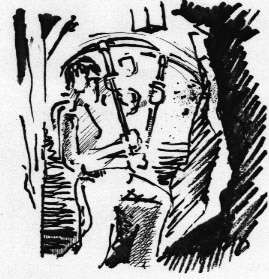Baldomero Lillo
Baldomero Lillo (1867–1923[1]) was a Chilean Naturalist author, whose works had social protest as their main theme.
Lillo's father traveled to California to participate in the 1848 Gold Rush, but returned with no fortune. He did learn much about mining, and he moved to southern Chile, Lota, to work the coal mines. Baldomero Lillo grew up in these mining communities and worked the mines himself. He was exposed to the writings of the French author Émile Zola, who used the philosophy of Positivism and the literary current of Naturalism to try to change the terrible conditions of French coal miners. Lillo was able to observe similar conditions in the Chilean mines and set out to improve the conditions of the workers by dramatizing their plight. Lillo wrote many short stories (collected in two major books, Sub Sole and Sub Terra) which sparked the interest of social activists who were appalled by the conditions in the mines. The story that follows is typical of his efforts.

In "The Devil's Tunnel" the miners are seemingly trapped by their destiny to live out their squalid and exploited lives, which are dominated by the need for raw materials and the machinery of the Europeans. At the story's end there is a strong contrast between the clean, pure and benevolent sky, and the underground monster that devours the humans who dare to penetrate its dark lair.
Excerpt: "The Devil's Tunnel", from Sub Terra
The excerpt below are the closing paragraphs of Lillo's short story about a miner who loses his life in an accident. His mother, who has lost her husband and two other sons in similar accidents, cannot emotionally deal with his death and dies in a suicidal jump into the mine, personified as a monster who consumes humans.
| “ | The body was lifted by the shoulders and feet and was laboriously placed in the waiting stretcher. María de los Angeles, upon seeing that ruddy face and that hair which now seemed drenched in blood, made a superhuman effort to throw herself on the body of her son. But pressed up against the barrier she could only move her arms as an inarticulate soundless cry burst from her throat. Then her muscles relaxed, her arms fell to her side and she stood motionless as if hit by a lightning bolt. The group parted and many faces turned toward the woman who, with her head on her chest, deep in an absolute trance, seemed absorbed in contemplating the abyss open at her feet. No one ever understood how she managed to jump over the barrier or the retaining cables. But many saw her for an instant as her bare legs dangled over empty space and she disappeared, without a sound, into the abyss. A few seconds later, a low and distant sound, almost imperceptible, erupted from the hungry mouth of the pit along with a few puffs of thin vapor: it was the breath of the monster gorged with blood in the depths of his lair. |
” |
Footnotes
- ↑ Chang-Rodriguez, Raquel, and Malva E. Filer. Voces de Hispanoamerica. 3rd ed. Boston: Thomson Heinle, 2004.
See also
References
- Adams, Nicholson B., et al. Hispanoamérica en su literatura. (2nd ed.) New York: W. W. Norton, 1993, pp. 225–234.
- Chang-Rodríguez, Raquel. Voces de Hispanoamérica. Boston: Heinle & Heinle, 2004, pp. 258–267.
- Child, Jack. Introduction to Latin American Literature: a Bilingual Anthology. Lanham: University Press of America,1994, pp. 197–210.
- Englekirk, John E. An Outline History of Spanish American Literature. New York: Appleton-Century-Crofts, 1965, pp. 92–93.
- Mujica, Bárbara. Texto y vida: introducción à la literatura hispanoamericana. New York: Harcourt Brace Jovanovich, 1992 p. 343.
External links
- Works by or about Baldomero Lillo at Internet Archive
- Works by Baldomero Lillo at LibriVox (public domain audiobooks)
